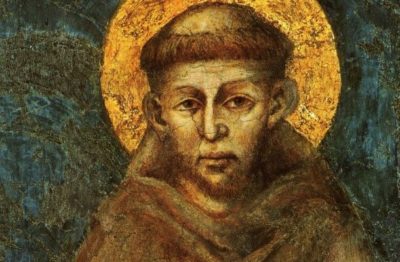 There are three events that seem to highlight the “period of crisis” in Francis life during the period from late 1205 until the summer of 1206:
There are three events that seem to highlight the “period of crisis” in Francis life during the period from late 1205 until the summer of 1206:
- Francis’ experiences at the abandoned San Damiano chapel – especially his prayers before the cross
- Francis’ “leaving the world” as he turns away from his family towards the Church and an unknown path with God.
- Francis and the leper (or lepers)
There is no consensus on the order of the events – and there is some question about later embellishments of the event – and even questions about whether some accounts indicating a single event is actually a compilation of a series of experiences. But then the 13th century writers were not trying to capture “history” they were trying to tell their understanding of the “meaning” of the life of St. Francis of Assisi.
What we do know is that within days before his death, Francis left a “testament” that begins as follows:
“[I began] doing penance in this way: for when I was in sin, it seemed too bitter to me to see lepers. And the Lord himself led me among them and I showed mercy to them. And when I left them, what had seemed bitter to me was turned in to sweetness of soul and body. And afterwards I delay a little and left the world” (Testament of St Francis 1-2).
The narrative about “the leper” that people are most familiar with comes from a second work by Thomas of Celano, the first biographer of St. Francis. Thomas wrote a second book, referred to as “2nd Celano” (2C) but more properly known as The Remembrance of the Desire of A Soul. This was written some twenty years after his first book based, partly on other’s works written since his own first work, and on a collection of “remembrances” from friars collected as the first generation of Friars began to pass away.
In 2C-9, we read:
“Among all the awful miseries of this world Francis had a natural horror of lepers, and one day as he was riding his horse near Assisi he met a leper on the road. He felt terrified and revolted, but not wanting to transgress God’s command and break the sacrament of His word, he dismounted from his horse and ran to kiss him. As the leper stretched out his hand, expecting something, he received both money and a kiss. Francis immediately mounted his horse and although the field was wide open, without any obstructions, when he looked around he could not see the leper anywhere.”
It is not difficult to see why modern scholars wonder about this account. Does it capture the core of a real event in Francis’ life, only to add the miraculous disappearance of the leper at the end as a way of saying that the meaning of the story is about Francis’ encounter with God in his encounter with the leper? Or is this simple account an illustrative one that simply condenses other experiences with the lepers of his day?
If you will remember, while Francis was still without direction and desperately searching for answers, he made a pilgrimage to Rome, returned and conferred with Bishop Guido of Assisi, and then began to wander the land outside Assisi. During that period of wandering, Thomas of Celano records that Francis began to minister and live at leprosarium (hostel for lepers) – perhaps near Assisi or Rivo Torto. After turning away from his family he again ministers at leprosarium (1C17). He lodged there and earned his keep caring for them. I think the Dominican historian, Fr. Augustine Thompson, has rightly discerned the impact of this on Francis’ life. He writes:
“It was a dramatic personal orientation that brought forth spiritual fruit. As Francis showed mercy to these outcasts, he came to experience God’s own gift of mercy to himself. As he cleaned the leper’s bodies, dressed their wounds, and treated them as human beings, not as refuse to be fled from in horror, his perceptions changed. What before was truly ugly and repulsive now caused him delight and joy, not only spiritually, but viscerally and physically. Francis’ aesthetic sense, so central to his personality, had been transformed, even inverted. The startled veteran sensed himself, by God’s grace and no power of his own, remade in to a different man. Just as suddenly, the sins that had been tormenting him seemed to melt away, and Francis experienced a kind of spiritual rebirth and healing. Not long after these encounters, later accounts tell us, perhaps in allegory, that Francis was walking down a road and met one of these same lepers. He embraced the man in his arms and kissed him. Francis’ spiritual nightmare was over; he had found peace” (Francis of Assisi: A New Biography, 17).